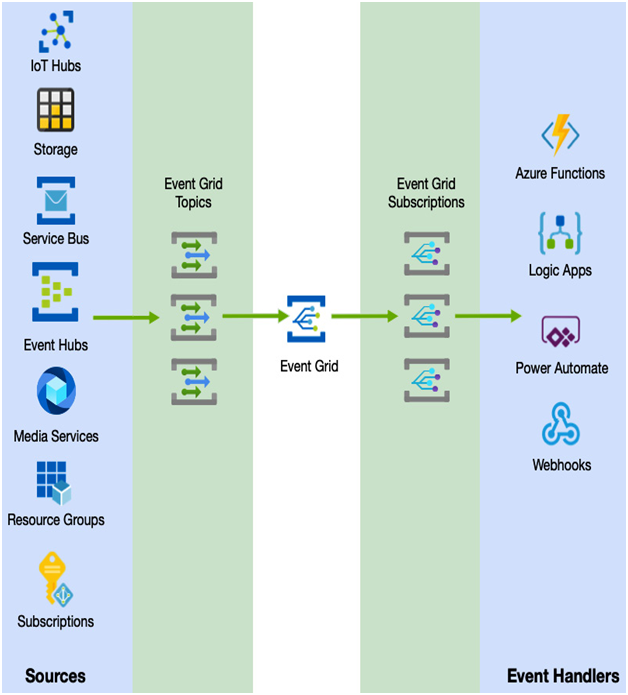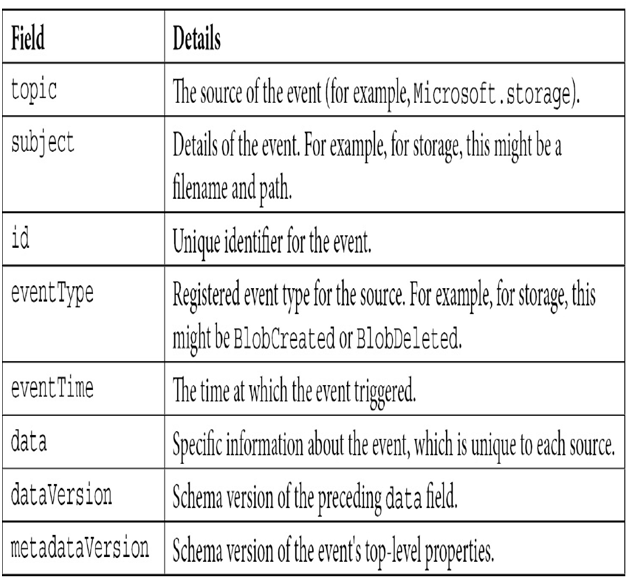When one component needs to inform another component that an event has happened, you need a mechanism to route that information from the sender to the consumer. Azure Event Grid provides this routing mechanism by routing events from an event source (the sender) to an event handler (the consumer), as we can see in the following diagram:

Figure 11.6 – Azure Event Grid sources and handlers
The following Azure components can all be event sources for Event Grid:
- Subscriptions and resource groups: Events are created within subscriptions and resource groups whenever an operation occurs within Azure, such as creating a VM, starting and stopping a VM, or deleting a VM.
- Azure Container Registry: When images are uploaded, changed, or removed, an event is triggered.
- Storage: When data is uploaded, changed, or removed in blobs, files, tables, and queues, an event is triggered.
- Media Services: Specific events for processing video and image media, such as job started or job completed.
- Service Bus: A messaging component can trigger events to inform subscribers that a message has been written to its queue.
- IoT Hub: Used to inform other Azure components about communication events occurring on IoT devices.
- Event Hubs: Used for ingesting large amounts of data.
- Customer events: Build custom events using the Azure SDK or REST API in the language of your choice.
An event is a lightweight JSON message, no larger than 64 KB in size, containing information about the occasion. The message always adheres to the following format:
[
{
“topic”: string,
“subject”: string,
“id”: string,
“eventType”: string,
“eventTime”: string,
“data”:{
object-unique-to-each-publisher
},
“dataVersion”: string,
“metadataVersion”: string
}
]
The details for each field are as follows:

Event Grid uses a publish and subscription mechanism. When a source triggers an event, it is defined in a topic. Consider a topic as a grouping for events, and your application may have one or more topics depending on the complexity and size.
There are two types of topics in Azure: system topics and custom topics. System topics are built into Azure sources, whereas custom topics are those you can build yourself.
Once a source has published an event to a topic, a consumer must subscribe to that event; in other words, it informs Event Grid that it wishes to be notified when events occur. The consumer then uses one or more event handlers that will perform some action.
Event handlers can be one or more of the following components in Azure:
- Azure Functions
- Webhooks
- Azure Logic Apps
- Microsoft Power Automate
We covered how to choose the best service from the preceding list in Chapter 7, Designing Compute Solutions.
Azure Event Grid is a simple mechanism for connecting sources to subscribers, and you can configure as many subscribers to an event as you need. Event Grid is a serverless product and, as such, is reliable, scalable, and cost-effective as you only pay for events as you transmit them.
For more advanced scenarios, for example, when you expect to deal with large volumes of events, Azure Event Hubs provides an intermediary for Event Grid.

Leave a Reply